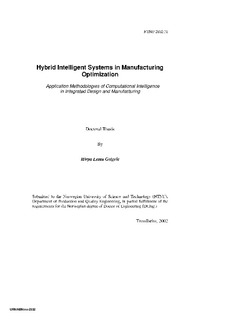| dc.description.abstract | The main objective of the work reported in this thesis has been to study and develop methodologies that can improve the communication gap between design and manufacturing systems. The emphasis has been on searching for the possible means of modeling and optimizing processes in an integrated design and manufacturing system environment using the combined capabilities (hybrids) of computational intelligence tools particularly that of artificial neural networks and genetic algorithms.
Within the last two decades, a trend of interest towards use of computers has been observed in almost all business activities. This has forced the industrial business to undergo dynamic profound changes with automation through information and communication technology being on the forefront of business success. Business in manufacturing engineering is no exceptional to this trend. Several functions in the manufacturing field such as design, process planning and manufacturing have enjoyed the recent advances in information and communication technology. However, the earlier isolated automation in each function have created a significant hindrance to smooth flow of information particularly because there has been a very high system incompatibility among the computerized systems.
One of the most difficult problems in modern manufacturing is the instability of production systems to mimic the basis human capabilities such as adjusting appropriately to the ever-changing environment. From past studies, it has been possible to witness that advances in theory and application methodology of artificial intelligence techniques can overcome many of the obstacles existing in manufacturing discipline. Today, the emergence of advanced computational methods in the artificial intelligence world such as genetic algorithms and neural networks, both inspired by the natural evolutionary process, has created a new field of research and application referred to as computational intelligence (CI) approach.
Accordingly, this thesis focuses on the application of computational intelligence tools from two main perspectives. On the one hand, instead of the isolated automation of each manufacturing function, the CI techniques have been considered as powerful tools that allow all functions to operate within a fully integrated and intelligent manufacturing system. Particularly, since process planning, is the main linking element between design and manufacturing functions, an automated and optimized process planning function creates a much more powerful environment that leads to the optimization of the whole process. Particularly, being able to integrate feature recognition and operation sequence optimization is an important element in the manufacturing system chain that can highly contribute to the automation and flexibility of the integrated design and manufacturing system. On the other hand, the computational intelligence techniques themselves have certain weakness of their own in solving the complex manufacturing process as a stand-alone form. In a hybrid form, however, they can either support or complement each other.
To realize these two points, this thesis has focused on the development of theories and application methodologies of hybrid computational intelligence systems to model and optimize complex manufacturing processes. The aim is to exploit the strong side of one computational intelligence tool and support or complement the weakness of the other. To this effect, qualitative analysis and reasoning of computational intelligence based hybrid systems are comprehensively discussed. The development theoretical backgrounds and methodologies are further used in key problem areas of the manufacturing system such as operation sequencing, machining economics analysis using multi-objective optimization approach and modeling and optimization of unstructured data collected from a non-conventional machining environment (electro-discharge machining). The results from the hybrid CI application to model and optimize the electro-discharge machine show that the methodology is also important not only to the industrial activities using this technology, but also promotes further research and application in the discipline. Though the focus in this thesis has been on discrete part manufacturing industries, it is important to mention that the facts, the developed methodologies and the discussed issues in the study are applicable to other industrial businesses. | nb_NO |
